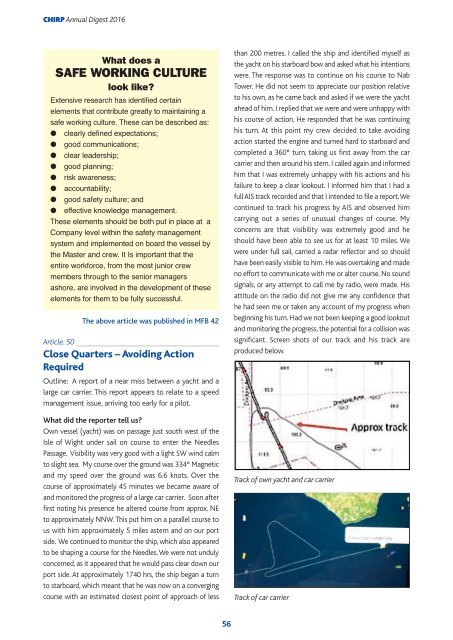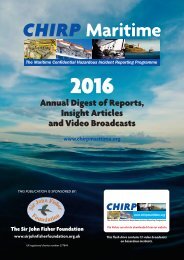CHIRP annual digest 2016 6th
You also want an ePaper? Increase the reach of your titles
YUMPU automatically turns print PDFs into web optimized ePapers that Google loves.
<strong>CHIRP</strong> Annual Digest <strong>2016</strong><br />
What does a<br />
SAFE WORKING CULTURE<br />
look like?<br />
Extensive research has identified certain<br />
elements that contribute greatly to maintaining a<br />
safe working culture. These can be described as:<br />
● clearly defined expectations;<br />
● good communications;<br />
● clear leadership;<br />
● good planning;<br />
● risk awareness;<br />
● accountability;<br />
● good safety culture; and<br />
● effective knowledge management.<br />
These elements should be both put in place at a<br />
Company level within the safety manage ment<br />
system and implemented on board the vessel by<br />
the Master and crew. It Is important that the<br />
entire workforce, from the most junior crew<br />
members through to the senior managers<br />
ashore, are involved in the development of these<br />
elements for them to be fully successful.<br />
The above article was published in MFB 42<br />
Article. 50<br />
Close Quarters – Avoiding Action<br />
Required<br />
Outline: A report of a near miss between a yacht and a<br />
large car carrier. This report appears to relate to a speed<br />
management issue, arriving too early for a pilot.<br />
What did the reporter tell us?<br />
Own vessel (yacht) was on passage just south west of the<br />
Isle of Wight under sail on course to enter the Needles<br />
Passage. Visibility was very good with a light SW wind calm<br />
to slight sea. My course over the ground was 334º Magnetic<br />
and my speed over the ground was 6.6 knots. Over the<br />
course of approximately 45 minutes we became aware of<br />
and monitored the progress of a large car carrier. Soon after<br />
first noting his presence he altered course from approx. NE<br />
to approximately NNW. This put him on a parallel course to<br />
us with him approximately 5 miles astern and on our port<br />
side. We continued to monitor the ship, which also appeared<br />
to be shaping a course for the Needles. We were not unduly<br />
concerned, as it appeared that he would pass clear down our<br />
port side. At approximately 1740 hrs, the ship began a turn<br />
to starboard, which meant that he was now on a converging<br />
course with an estimated closest point of approach of less<br />
than 200 metres. I called the ship and identified myself as<br />
the yacht on his starboard bow and asked what his intentions<br />
were. The response was to continue on his course to Nab<br />
Tower. He did not seem to appreciate our position relative<br />
to his own, as he came back and asked if we were the yacht<br />
ahead of him. I replied that we were and were unhappy with<br />
his course of action. He responded that he was continuing<br />
his turn. At this point my crew decided to take avoiding<br />
action started the engine and turned hard to starboard and<br />
completed a 360º turn, taking us first away from the car<br />
carrier and then around his stern. I called again and informed<br />
him that I was extremely unhappy with his actions and his<br />
failure to keep a clear lookout. I informed him that I had a<br />
full AIS track recorded and that I intended to file a report. We<br />
continued to track his progress by AIS and observed him<br />
carrying out a series of unusual changes of course. My<br />
concerns are that visibility was extremely good and he<br />
should have been able to see us for at least 10 miles. We<br />
were under full sail, carried a radar reflector and so should<br />
have been easily visible to him. He was overtaking and made<br />
no effort to communicate with me or alter course. No sound<br />
signals, or any attempt to call me by radio, were made. His<br />
attitude on the radio did not give me any confidence that<br />
he had seen me or taken any account of my progress when<br />
beginning his turn. Had we not been keeping a good lookout<br />
and monitoring the progress, the potential for a collision was<br />
significant. Screen shots of our track and his track are<br />
produced below.<br />
Track of own yacht and car carrier<br />
Track of car carrier<br />
56



